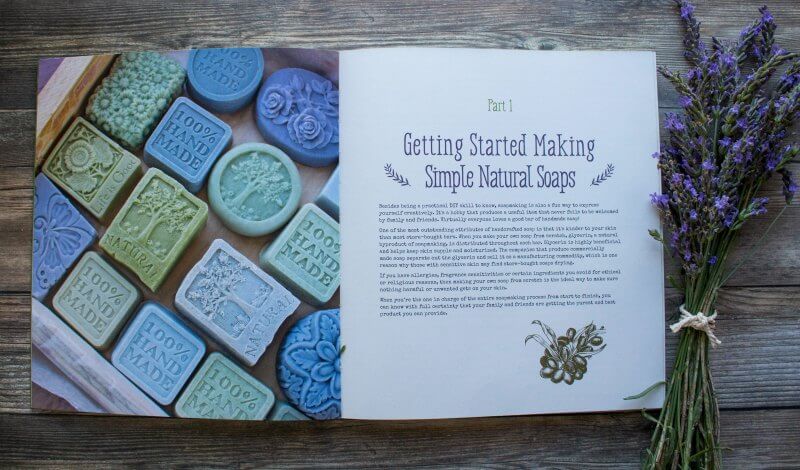It’s no secret the planet is awash in plastic trash, so anything we can do to avoid using single-use plastic items like bottles, straws, and bags is a win for both conserving resources and preventing pollution.
By using a shampoo bar in lieu of bottled shampoo, you’ll get beautiful locks while reducing waste, and saving both natural resources and money. And by making your own shampoo bars and soaps, you’ll save even more money, and feel great about the safe, food-grade ingredients you are using to cleanse your hair and body.
Simple & Natural Soapmaking

Soapmaking is a fun and practical hobby, as well as a valuable homesteading skill. Homemade soap also makes a gorgeous, affordable gift for almost any occasion.
But even if you just want to dabble, my favorite book on the subject, Simple & Natural Soapmaking, is a very thorough resource for any brand-new soap maker, with fun ideas for someone with more experience as well.
In her comprehensive guide, herbalist Jan Berry offers detailed tutorials and step-by-step photographs for making traditional cold-process soap and the more modern hot-process method with a slow cooker.
There are 50 easy, unique soap recipes with ingredients and scents inspired by the herb garden, veggie garden, farm, forest and more.
Below is one of my favorite shampoo bar recipes from her book.

Coconut Milk Shampoo Bar Recipe
In this recipe, a double-strength lye solution is made first, using only half the amount of water that a regular soap recipe would normally use. Then coconut milk is added to the oils to make up the remaining liquid balance.
With its high lauric acid content, coconut milk ensures this shampoo bar recipe has a bubbly lather and extra creamy feel, while jojoba oil adds a touch of luxury that’s fantastic for promoting healthy, shiny hair.
Shampoo sticks are a fun alternative to the traditional bar-shaped soap made by simply cutting a regular shampoo bar into thirds. Their smaller size makes them easy to handle and convenient to use. Feel free to leave the bar uncut, but you’ll need extra curing time.
More DIY Personal Care Products:

Coconut Milk Shampoo Bars
Ingredients
- 4.5 oz distilled water
- 3.85 oz sodium hydroxide (lye)
- 4 oz full-fat coconut milk
- 7.5 oz virgin coconut oil
- 12 oz olive oil
- 3.5 oz almond oil, or sub sunflower
- 4 oz castor oil
- 1 oz jojoba oil, Substitution: If jojoba isn’t available, try substituting with more sunflower or sweet almond oil in its place. The lye amount will not need to be adjusted.
Instructions
- Wearing protective gloves and eyewear, carefully stir the lye into the distilled water, then set the lye solution aside in a safe place to cool for about 30 to 40 minutes or until the temperature drops to around 100 to 110°F (38 to 43°C).
- Melt the coconut oil, then add to the other oils. Add the coconut milk to the warm oils and use an immersion blender for a few seconds until thoroughly combined.
- Add the lye solution to the warm oils and coconut milk mixture. Using a combination of hand stirring and an immersion blender, stir the soap until it reaches a light trace. (See photo, right.)
- Pour into a prepared mold. Cover lightly with a sheet of wax or freezer paper, then a towel or light blanket. Peek at the soap every so often; if it starts developing a crack, uncover and move it to a cooler location.
- Keep the soap in the mold for 1 to 2 days, or until it’s easy to remove, then slice it into bars when it’s firm enough not to stick to your cutting tool.
- To make shampoo sticks, cut each bar into thirds. Cure on coated cooling racks or sheets of wax paper about 4 weeks before using.














24 thoughts on “Coconut Milk Shampoo Bars”